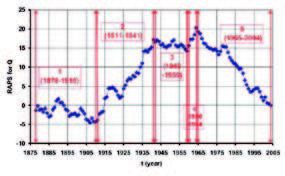Analysis of Long-Term (1878-2004) Mean Annual Discharges of the Karst Spring Fontaine de Vaucluse (France)
DOI:
https://doi.org/10.3986/ac.v36i1.217Povzetek
Statistical analyses have been carried out on a long-term (1878-2004) series of mean annual discharges of the famous karst spring Fontaine de Vaucluse (France) and the mean annual rainfall in its catchment. The Fontaine de Vaucluse is a typical ascending karst spring situated in the south-eastern region of France. The spring has an average discharge of 23.3 m3/s. The average annual rainfall is 1096 mm. Its catchment area covers 1130 km2. Using the rescaled adjusted partial sums (RAPS) method the existence of next five statistically significant different sub-series was established: 1) 1878-1910: 2) 1911-1941; 3) 1942-1959: 4) 1960-1964; 5) 1965-2004. The different spring discharge characteristics during this long period (1878-2004) can be caused by natural climatic variations, by anthropogenic influences, and possibly by climate changes. At this moment it should be stressed that objective and scientifically based reasons for different hydrological behaviour in five time sub-periods could not be found.
Prenosi

Prenosi
Objavljeno
Kako citirati
Številka
Rubrike
Licenca
Avtorji jamčijo, da je delo njihova avtorska stvaritev, da v njem niso kršene avtorske pravice tretjih oseb ali kake druge pravice. V primeru zahtevkov tretjih oseb se avtorji zavezujejo, da bodo varovali interese založnika ter da bodo povrnili morebitno škodo.
Podrobneje v rubriki: Prispevki




